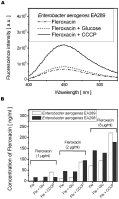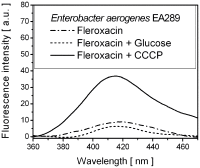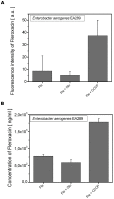Antibiotic transport in resistant bacteria: synchrotron UV fluorescence microscopy to determine antibiotic accumulation with single cell resolution
- PMID: 22719907
- PMCID: PMC3373604
- DOI: 10.1371/journal.pone.0038624
Antibiotic transport in resistant bacteria: synchrotron UV fluorescence microscopy to determine antibiotic accumulation with single cell resolution
Abstract
A molecular definition of the mechanism conferring bacterial multidrug resistance is clinically crucial and today methods for quantitative determination of the uptake of antimicrobial agents with single cell resolution are missing. Using the naturally occurring fluorescence of antibacterial agents after deep ultraviolet (DUV) excitation, we developed a method to non-invasively monitor the quinolones uptake in single bacteria. Our approach is based on a DUV fluorescence microscope coupled to a synchrotron beamline providing tuneable excitation from 200 to 600 nm. A full spectrum was acquired at each pixel of the image, to study the DUV excited fluorescence emitted from quinolones within single bacteria. Measuring spectra allowed us to separate the antibiotic fluorescence from the autofluorescence contribution. By performing spectroscopic analysis, the quantification of the antibiotic signal was possible. To our knowledge, this is the first time that the intracellular accumulation of a clinical antibiotic could be determined and discussed in relation with the level of drug susceptibility for a multiresistant strain. This method is especially important to follow the behavior of quinolone molecules at individual cell level, to quantify the intracellular concentration of the antibiotic and develop new strategies to combat the dissemination of MDR-bacteria. In addition, this original approach also indicates the heterogeneity of bacterial population when the same strain is under environmental stress like antibiotic attack.
Conflict of interest statement
Figures





Similar articles
-
Synchrotron UV fluorescence microscopy uncovers new probes in cells and tissues.Microsc Microanal. 2010 Oct;16(5):507-14. doi: 10.1017/S1431927610093852. Epub 2010 Aug 25. Microsc Microanal. 2010. PMID: 20738889
-
Diffusion of ofloxacin in the endocarditis vegetation assessed with synchrotron radiation UV fluorescence microspectroscopy.PLoS One. 2011 Apr 29;6(4):e19440. doi: 10.1371/journal.pone.0019440. PLoS One. 2011. PMID: 21559378 Free PMC article.
-
Microspectrometric insights on the uptake of antibiotics at the single bacterial cell level.Sci Rep. 2015 Dec 11;5:17968. doi: 10.1038/srep17968. Sci Rep. 2015. PMID: 26656111 Free PMC article.
-
Inhibitors of multidrug resistant efflux systems in bacteria.Recent Pat Antiinfect Drug Discov. 2009 Jan;4(1):37-50. doi: 10.2174/157489109787236256. Recent Pat Antiinfect Drug Discov. 2009. PMID: 19149695 Review.
-
The role of efflux pumps ın antıbıotıc resıstance of gram negatıve rods.Arch Microbiol. 2023 Apr 15;205(5):192. doi: 10.1007/s00203-023-03539-3. Arch Microbiol. 2023. PMID: 37060362 Review.
Cited by
-
Efflux Pump Blockers in Gram-Negative Bacteria: The New Generation of Hydantoin Based-Modulators to Improve Antibiotic Activity.Front Microbiol. 2016 May 3;7:622. doi: 10.3389/fmicb.2016.00622. eCollection 2016. Front Microbiol. 2016. PMID: 27199950 Free PMC article.
-
Fluoroquinolone-derived fluorescent probes for studies of bacterial penetration and efflux.Medchemcomm. 2019 May 17;10(6):901-906. doi: 10.1039/c9md00124g. eCollection 2019 Jun 1. Medchemcomm. 2019. PMID: 31303987 Free PMC article.
-
Cell localisation of gadolinium-based nanoparticles and related radiosensitising efficacy in glioblastoma cells.Cancer Nanotechnol. 2014;5(1):6. doi: 10.1186/s12645-014-0006-6. Epub 2014 Oct 10. Cancer Nanotechnol. 2014. PMID: 25328549 Free PMC article.
-
Defining new chemical space for drug penetration into Gram-negative bacteria.Nat Chem Biol. 2020 Dec;16(12):1293-1302. doi: 10.1038/s41589-020-00674-6. Epub 2020 Nov 16. Nat Chem Biol. 2020. PMID: 33199906 Free PMC article. Review.
-
Single-cell microfluidics facilitates the rapid quantification of antibiotic accumulation in Gram-negative bacteria.Lab Chip. 2020 Aug 7;20(15):2765-2775. doi: 10.1039/d0lc00242a. Epub 2020 Jul 2. Lab Chip. 2020. PMID: 32613221 Free PMC article.
References
-
- de Kraker MEA, Davey PG, Grundmann H on behalf of the BURDEN study group. Mortality and Hospital Stay Associated with Resistant Staphylococcus aureus and Escherichia coli Bacteremia: Estimating the Burden of Antibiotic Resistance in Europe. PloS Med 8(10): e1001104. doi:10.1371/journal.pmed.1001104. 2011. - PMC - PubMed
-
- Rice LB. Emerging issues in the management of infections caused by multidrug-resistant gram-negative bacteria. Cleve Clin J Med. 2007;74:S12–20. - PubMed
-
- Falagas ME, Bliziotis IA. Pandrug-resistant Gram-negative bacteria: the dawn of the post-antibiotic era? Int J Antimicrob Agents. 2007;29:630–636. - PubMed
-
- Blot S, Depuydt P, Vandewoude K, De Bacquer D. Measuring the impact of multidrug resistance in nosocomial infection. Curr Opin Infect Dis. 2007;20:391–396. - PubMed
Publication types
MeSH terms
Substances
LinkOut - more resources
Full Text Sources
Other Literature Sources
Medical

